Commercial Vehicle Intelligent Chassis Industry Report, 2023, released by ResearchInChina, combs through and researches status quo and related product layout of OEMs and suppliers, and predicts future development trends of commercial vehicle intelligent chassis.
China-SAE defines intelligent chassis as a platform that provides bearing for autonomous driving system, cockpit system, and power system, with capabilities of cognition, prediction, control of interaction between wheels and the ground, and management of its own operating state, and specifically a system implementing vehicle intelligent driving tasks. Referring to the Electric Vehicle Intelligent Chassis Technology Roadmap, currently the development of commercial vehicle intelligent chassis in China focuses on four components, namely, brake-by-wire, steer-by-wire, drive-by-wire, and intelligent suspension. In the trend for commercial vehicle electrification, connection and intelligence, intelligent chassis, as a development cornerstone of vehicle intelligence, has become a development priority of the industry.
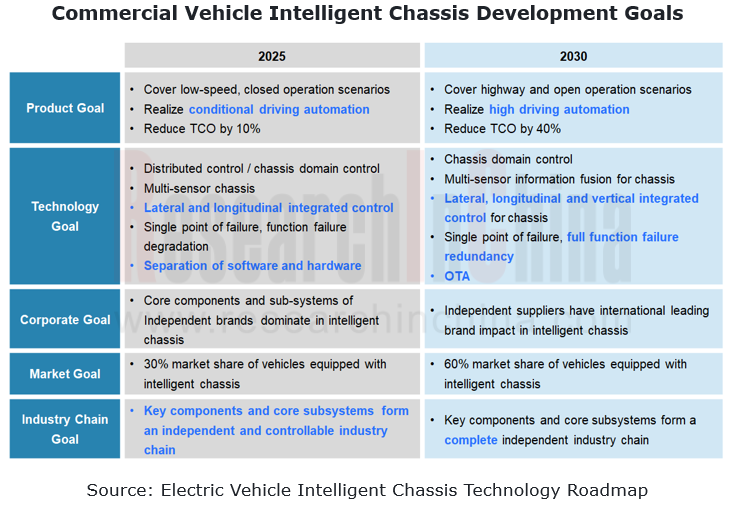
1. OEMs and suppliers accelerate layout of intelligent chassis
Driven by national policies and market demand, OEMs and suppliers have quickened their pace of deploying intelligent chassis to solve the current problem of "insufficiently flexible limbs" in commercial vehicle chassis and support intelligent upgrade of commercial vehicle chassis.
- In 2023, a light commercial vehicle based on skateboard chassis of Farizon Auto (Top 2 in new energy light trucks) will be launched on market in small batches. SuperVAN, Farizon Auto develops using skateboard chassis technology, covers vehicles with gross mass of 2.5 to 5.5 tons, length of 4.5 to 6 meters, and height ranging from flat roof (1.98 meters) and medium roof (2.18 meters, capable of entering underground garages) to high roof (2.5 meters).
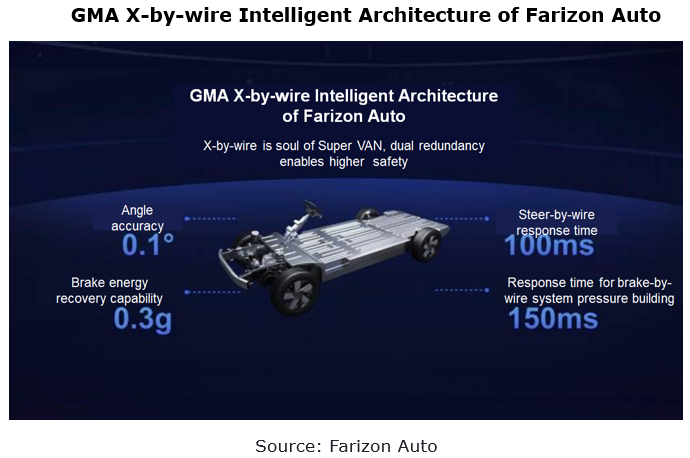
- In May 2023, Qingling Motors first introduced its new-generation light electric truck, M600. The commercial vehicle skateboard chassis technology used in the new vehicle integrates three major components of battery, motor, and ECU, as well as drive/steer-by-wire and thermal management in the chassis according to three major domains, bringing much lower redundancy.
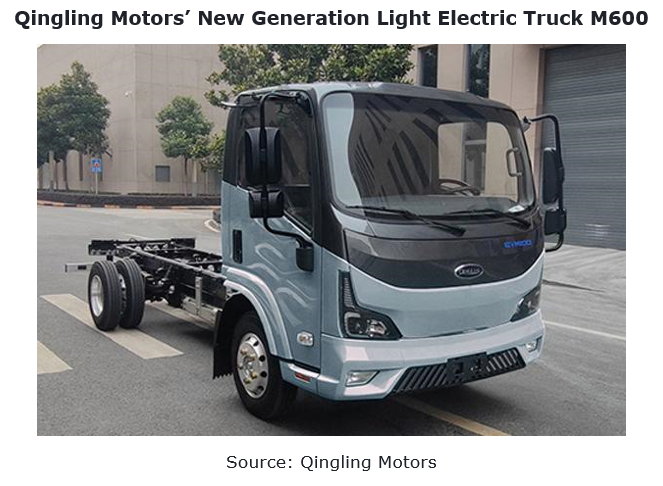
- In March 2023, U POWER released UP Super Board, a skateboard chassis-by-wire which provides support for building small trucks, light buses, vans and light trucks, with length of 4.5-6 meters and load capacity of 2.5-4.5 tons.
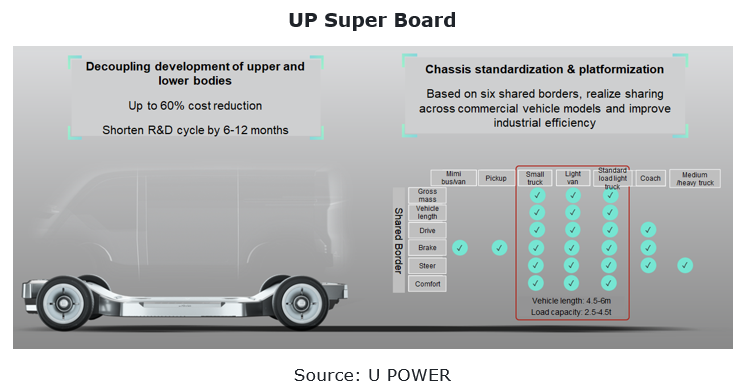
2. Breakthroughs are made in electronic hydraulic brake-by-wire systems for commercial vehicles
Commercial vehicles with large loads have high requirements for braking systems: large braking force, high system reliability requirements, and high control difficulty due to large variation in load. Originally commercial vehicles mainly used air brake systems, but hydraulic brakes find ever broader application in light commercial vehicles, for offering benefits of quick braking response, short braking distance, low cost, a small number of parts, lighter weight, and low maintenance.
Application of brake-by-wire in commercial vehicles started from electronic braking system (EBS). As early as 1996, WABCO's EBS was used in Mercedes-Benz ACTROS series commercial vehicles. In recent years, electronic hydraulic brake-by-wire systems have also been mass-produced and installed in commercial vehicles. In China, typical suppliers are Tongyu Auto, Trinova Auto, and Tsintel Technology.
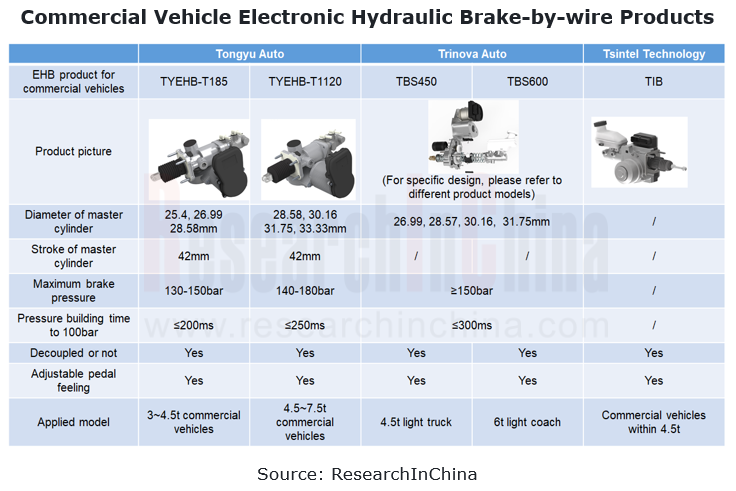
Tongyu Auto is incubated by Tongji University, and its core team has independently developed core chassis-by-wire technologies since 2012. It has gained capital investment from OEMs such as Dongfeng, BAIC, China South Industries Group Corporation (CSGC), and Xiaomi. Among them, Xiaomi has successively participated in its A+ and B funding rounds.
In Tongyu Auto’s commercial vehicle products, large EHB platform products are applicable to 3t to 7.5t mini trucks, mini coaches, pickups, light trucks, light buses and minibuses; combined braking system solutions can also cover vehicles with load capacity of 12t, further meeting the application requirements of medium-sized trucks and coaches. At present, Tongyu Auto's products have supported dozens of Chinese OEMs, such as FAW Jiefang, Dongfeng, JAC, JMC, SANY Heavy Industry, BAIC Foton, Yutong Group, XCMG, and King Long. Tongyu Auto ranks first in the Chinese commercial vehicle brake-by-wire EHB market.
3. Standardized intelligent chassis matches upper bodies of differing loads according to commercial vehicle application scenarios
Standardized intelligent chassis matching intelligent cabins and scenario-based upper bodies at random meets the requirements of different commercial vehicle scenarios.
- Standardized chassis. Meet requirements of large-scale production for product standardization and reduce production cost. Moreover standardized chassis provides technical support for the development of commercial vehicle sharing.
- General cabin. An intelligent cabin can be connected to a variety of standardized intelligent chassis via specific standardized mechanical interfaces, so as to realize plug-and-play.
- Scenario-based upper body. Upper body is customized according to scenarios to differentially meet specialized needs of scenarios and maximize usage efficiency in the scenarios.
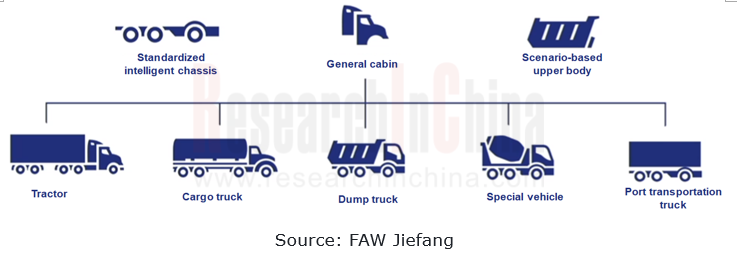
Chassis standardization also facilitates technical development of chassis sub-components. The first is X-by-wire technology. Electronic control replaces mechanical control, completing the process of chassis intelligence 1.0. Once steer-by-wire and brake-by-wire technologies are mature, corner modules may be developed by referring to passenger car chassis to put steering and braking close to wheels. Schaeffler is developing related products. The second is structured battery pack, with battery cells directly integrated into vehicle frame/body to reduce weight and simplify structure. Currently all-electric heavy and light trucks already implement CTP (Cell to PACK) technology, while CTC (Cell to Chassis) technology develops with skateboard chassis as the carrier.
Both OEMs and suppliers now have made layout of standardized intelligent chassis:
- Representative products of OEMs: King Long’s AICO chassis-by-wire, SANY Heavy Industry’s intelligent chassis, Qingling Motors’ all-electric light truck skateboard chassis, Beiben Trucks’ all-electric non-cabin intelligent chassis, etc.
- Representative products of suppliers: Kunlang Technology’s autonomous commercial vehicles, PIX’s skateboard chassis EMC platform, REE’s P7 series chassis, all-electric chassis of Ifyou Technology (a wholly-owned subsidiary of GWM) for new Changzheng No.1 special vehicles, etc.
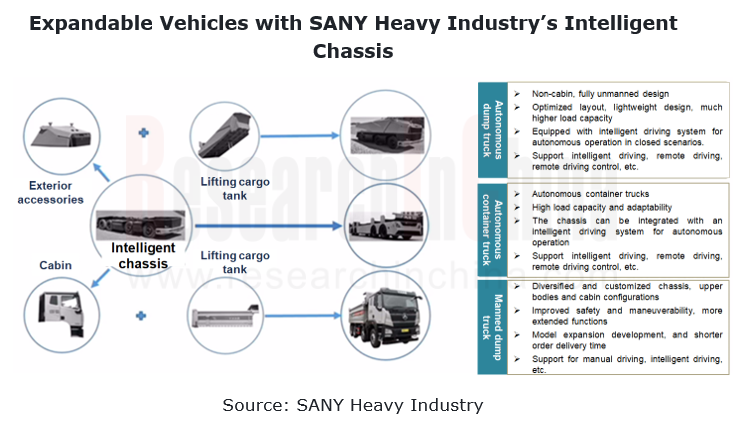
4. Battery-chassis integration reshapes supply relationships
In the wave of commercial vehicle electrification, batteries have become another critical component on chassis. At present all-electric commercial vehicles have been promoting CTP and CTC technology, and power battery core technologies are held by major battery manufacturers which have a bigger say in promoting battery-chassis integration.
In CATL’s case, it set up CATL (Shanghai) Intelligent Technology Co., Ltd., its wholly-owned subsidiary specializing in design, production, sales and service of CIIC (CATL Integrated Intelligent Chassis), and has laid out an integrated intelligent chassis production base construction project in Yichun in January 2023.
Conventional battery manufacturers are transforming into integrated suppliers of batteries and chassis. According to relevant research, in the future more than 70% of profits from new energy commercial vehicles will be taken by battery companies. Battery companies are extending downward to the chassis. Commercial vehicle OEMs need to further consider how to have the initiative in development of new energy technologies in the future.
Autonomous Driving Domain Controller and Central Computing Unit (CCU) Industry Report, 2025
Research on Autonomous Driving Domain Controllers: Monthly Penetration Rate Exceeded 30% for the First Time, and 700T+ Ultrahigh-compute Domain Controller Products Are Rapidly Installed in Vehicles
L...
China Automotive Lighting and Ambient Lighting System Research Report, 2025
Automotive Lighting System Research: In 2025H1, Autonomous Driving System (ADS) Marker Lamps Saw an 11-Fold Year-on-Year Growth and the Installation Rate of Automotive LED Lighting Approached 90...
Ecological Domain and Automotive Hardware Expansion Research Report, 2025
ResearchInChina has released the Ecological Domain and Automotive Hardware Expansion Research Report, 2025, which delves into the application of various automotive extended hardware, supplier ecologic...
Automotive Seating Innovation Technology Trend Research Report, 2025
Automotive Seating Research: With Popularization of Comfort Functions, How to Properly "Stack Functions" for Seating?
This report studies the status quo of seating technologies and functions in aspe...
Research Report on Chinese Suppliers’ Overseas Layout of Intelligent Driving, 2025
Research on Overseas Layout of Intelligent Driving: There Are Multiple Challenges in Overseas Layout, and Light-Asset Cooperation with Foreign Suppliers Emerges as the Optimal Solution at Present
20...
High-Voltage Power Supply in New Energy Vehicle (BMS, BDU, Relay, Integrated Battery Box) Research Report, 2025
The high-voltage power supply system is a core component of new energy vehicles. The battery pack serves as the central energy source, with the capacity of power battery affecting the vehicle's range,...
Automotive Radio Frequency System-on-Chip (RF SoC) and Module Research Report, 2025
Automotive RF SoC Research: The Pace of Introducing "Nerve Endings" such as UWB, NTN Satellite Communication, NearLink, and WIFI into Intelligent Vehicles Quickens
RF SoC (Radio Frequency Syst...
Automotive Power Management ICs and Signal Chain Chips Industry Research Report, 2025
Analog chips are used to process continuous analog signals from the natural world, such as light, sound, electricity/magnetism, position/speed/acceleration, and temperature. They are mainly composed o...
Global and China Electronic Rearview Mirror Industry Report, 2025
Based on the installation location, electronic rearview mirrors can be divided into electronic interior rearview mirrors (i.e., streaming media rearview mirrors) and electronic exterior rearview mirro...
Intelligent Cockpit Tier 1 Supplier Research Report, 2025 (Chinese Companies)
Intelligent Cockpit Tier1 Suppliers Research: Emerging AI Cockpit Products Fuel Layout of Full-Scenario Cockpit Ecosystem
This report mainly analyzes the current layout, innovative products, and deve...
Next-generation Central and Zonal Communication Network Topology and Chip Industry Research Report, 2025
The automotive E/E architecture is evolving towards a "central computing + zonal control" architecture, where the central computing platform is responsible for high-computing-power tasks, and zonal co...
Vehicle-road-cloud Integration and C-V2X Industry Research Report, 2025
Vehicle-side C-V2X Application Scenarios: Transition from R16 to R17, Providing a Communication Base for High-level Autonomous Driving, with the C-V2X On-board Explosion Period Approaching
In 2024, t...
Intelligent Cockpit Patent Analysis Report, 2025
Patent Trend: Three Major Directions of Intelligent Cockpits in 2025
This report explores the development trends of cutting-edge intelligent cockpits from the perspective of patents. The research sco...
Smart Car Information Security (Cybersecurity and Data Security) Research Report, 2025
Research on Automotive Information Security: AI Fusion Intelligent Protection and Ecological Collaboration Ensure Cybersecurity and Data Security
At present, what are the security risks faced by inte...
New Energy Vehicle 800-1000V High-Voltage Architecture and Supply Chain Research Report, 2025
Research on 800-1000V Architecture: to be installed in over 7 million vehicles in 2030, marking the arrival of the era of full-domain high voltage and megawatt supercharging.
In 2025, the 800-1000V h...
Foreign Tier 1 ADAS Suppliers Industry Research Report 2025
Research on Overseas Tier 1 ADAS Suppliers: Three Paths for Foreign Enterprises to Transfer to NOA
Foreign Tier 1 ADAS suppliers are obviously lagging behind in the field of NOA.
In 2024, Aptiv (2.6...
VLA Large Model Applications in Automotive and Robotics Research Report, 2025
ResearchInChina releases "VLA Large Model Applications in Automotive and Robotics Research Report, 2025": The report summarizes and analyzes the technical origin, development stages, application cases...
OEMs’ Next-generation In-vehicle Infotainment (IVI) System Trends Report, 2025
ResearchInChina releases the "OEMs’ Next-generation In-vehicle Infotainment (IVI) System Trends Report, 2025", which sorts out iterative development context of mainstream automakers in terms of infota...